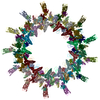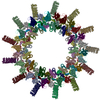+ Open data
Open data
- Basic information
Basic information
| Entry | Database: PDB / ID: 6x62 | ||||||||||||||||||||||||
|---|---|---|---|---|---|---|---|---|---|---|---|---|---|---|---|---|---|---|---|---|---|---|---|---|---|
| Title | Legionella pneumophila Dot T4SS OMC | ||||||||||||||||||||||||
 Components Components |
| ||||||||||||||||||||||||
 Keywords Keywords | PROTEIN TRANSPORT / Secretion / T4SS / Dot | ||||||||||||||||||||||||
| Function / homology |  Function and homology information Function and homology information | ||||||||||||||||||||||||
| Biological species |  | ||||||||||||||||||||||||
| Method | ELECTRON MICROSCOPY / single particle reconstruction / cryo EM / Resolution: 3.5 Å | ||||||||||||||||||||||||
 Authors Authors | Durie, C.L. / Sheedlo, M.J. / Chung, J.M. / Byrne, B.G. / Su, M. / Knight, T. / Swanson, M.S. / Lacy, D.B. / Ohi, M.D. | ||||||||||||||||||||||||
| Funding support |  United States, 7items United States, 7items
| ||||||||||||||||||||||||
 Citation Citation |  Journal: Elife / Year: 2020 Journal: Elife / Year: 2020Title: Structural analysis of the Dot/Icm type IV secretion system core complex. Authors: Clarissa L Durie / Michael J Sheedlo / Jeong Min Chung / Brenda G Byrne / Min Su / Thomas Knight / Michele Swanson / D Borden Lacy / Melanie D Ohi /  Abstract: is an opportunistic pathogen that causes the potentially fatal pneumonia Legionnaires' Disease. This infection and subsequent pathology require the Dot/Icm Type IV Secretion System (T4SS) to deliver ... is an opportunistic pathogen that causes the potentially fatal pneumonia Legionnaires' Disease. This infection and subsequent pathology require the Dot/Icm Type IV Secretion System (T4SS) to deliver effector proteins into host cells. Compared to prototypical T4SSs, the Dot/Icm assembly is much larger, containing ~27 different components including a core complex reported to be composed of five proteins: DotC, DotD, DotF, DotG, and DotH. Using single particle cryo-electron microscopy (cryo-EM), we report reconstructions of the core complex of the Dot/Icm T4SS that includes a symmetry mismatch between distinct structural features of the outer membrane cap (OMC) and periplasmic ring (PR). We present models of known core complex proteins, DotC, DotD, and DotH, and two structurally similar proteins within the core complex, DotK and Lpg0657. This analysis reveals the stoichiometry and contact interfaces between the key proteins of the Dot/Icm T4SS core complex and provides a framework for understanding a complex molecular machine. | ||||||||||||||||||||||||
| History |
|
- Structure visualization
Structure visualization
| Movie |
 Movie viewer Movie viewer |
|---|---|
| Structure viewer | Molecule:  Molmil Molmil Jmol/JSmol Jmol/JSmol |
- Downloads & links
Downloads & links
- Download
Download
| PDBx/mmCIF format |  6x62.cif.gz 6x62.cif.gz | 2.7 MB | Display |  PDBx/mmCIF format PDBx/mmCIF format |
|---|---|---|---|---|
| PDB format |  pdb6x62.ent.gz pdb6x62.ent.gz | Display |  PDB format PDB format | |
| PDBx/mmJSON format |  6x62.json.gz 6x62.json.gz | Tree view |  PDBx/mmJSON format PDBx/mmJSON format | |
| Others |  Other downloads Other downloads |
-Validation report
| Summary document |  6x62_validation.pdf.gz 6x62_validation.pdf.gz | 1.8 MB | Display |  wwPDB validaton report wwPDB validaton report |
|---|---|---|---|---|
| Full document |  6x62_full_validation.pdf.gz 6x62_full_validation.pdf.gz | 1.9 MB | Display | |
| Data in XML |  6x62_validation.xml.gz 6x62_validation.xml.gz | 337.5 KB | Display | |
| Data in CIF |  6x62_validation.cif.gz 6x62_validation.cif.gz | 549.1 KB | Display | |
| Arichive directory |  https://data.pdbj.org/pub/pdb/validation_reports/x6/6x62 https://data.pdbj.org/pub/pdb/validation_reports/x6/6x62 ftp://data.pdbj.org/pub/pdb/validation_reports/x6/6x62 ftp://data.pdbj.org/pub/pdb/validation_reports/x6/6x62 | HTTPS FTP |
-Related structure data
| Related structure data |  22068MC  6x64C  6x65C  6x66C M: map data used to model this data C: citing same article ( |
|---|---|
| Similar structure data |
- Links
Links
- Assembly
Assembly
| Deposited unit | 
|
|---|---|
| 1 |
|
- Components
Components
| #1: Protein | Mass: 34162.441 Da / Num. of mol.: 13 / Source method: isolated from a natural source / Source: (natural)  #2: Protein | Mass: 38958.926 Da / Num. of mol.: 13 / Source method: isolated from a natural source / Source: (natural)  #3: Protein | Mass: 21096.492 Da / Num. of mol.: 13 / Source method: isolated from a natural source / Source: (natural)  #4: Protein | Mass: 51037.672 Da / Num. of mol.: 52 / Source method: isolated from a natural source / Source: (natural)  #5: Protein | Mass: 17860.678 Da / Num. of mol.: 26 / Source method: isolated from a natural source / Source: (natural)  |
|---|
-Experimental details
-Experiment
| Experiment | Method: ELECTRON MICROSCOPY |
|---|---|
| EM experiment | Aggregation state: PARTICLE / 3D reconstruction method: single particle reconstruction |
- Sample preparation
Sample preparation
| Component | Name: Legionella pneumophila Dot T4SS OMC / Type: COMPLEX / Entity ID: all / Source: NATURAL |
|---|---|
| Molecular weight | Experimental value: NO |
| Source (natural) | Organism:  |
| Buffer solution | pH: 7 |
| Specimen | Embedding applied: NO / Shadowing applied: NO / Staining applied: NO / Vitrification applied: YES |
| Vitrification | Cryogen name: ETHANE |
- Electron microscopy imaging
Electron microscopy imaging
| Experimental equipment |  Model: Titan Krios / Image courtesy: FEI Company |
|---|---|
| Microscopy | Model: FEI TITAN KRIOS |
| Electron gun | Electron source:  FIELD EMISSION GUN / Accelerating voltage: 300 kV / Illumination mode: FLOOD BEAM FIELD EMISSION GUN / Accelerating voltage: 300 kV / Illumination mode: FLOOD BEAM |
| Electron lens | Mode: BRIGHT FIELD |
| Image recording | Electron dose: 58.1 e/Å2 / Film or detector model: GATAN K2 SUMMIT (4k x 4k) |
- Processing
Processing
| Software |
| ||||||||||||||||||||||||
|---|---|---|---|---|---|---|---|---|---|---|---|---|---|---|---|---|---|---|---|---|---|---|---|---|---|
| CTF correction | Type: PHASE FLIPPING AND AMPLITUDE CORRECTION | ||||||||||||||||||||||||
| Particle selection | Num. of particles selected: 771806 | ||||||||||||||||||||||||
| Symmetry | Point symmetry: C13 (13 fold cyclic) | ||||||||||||||||||||||||
| 3D reconstruction | Resolution: 3.5 Å / Resolution method: FSC 0.143 CUT-OFF / Num. of particles: 12200 / Symmetry type: POINT | ||||||||||||||||||||||||
| Refinement | Cross valid method: NONE Stereochemistry target values: GeoStd + Monomer Library + CDL v1.2 | ||||||||||||||||||||||||
| Displacement parameters | Biso mean: 113.46 Å2 | ||||||||||||||||||||||||
| Refine LS restraints |
|
 Movie
Movie Controller
Controller








 PDBj
PDBj




